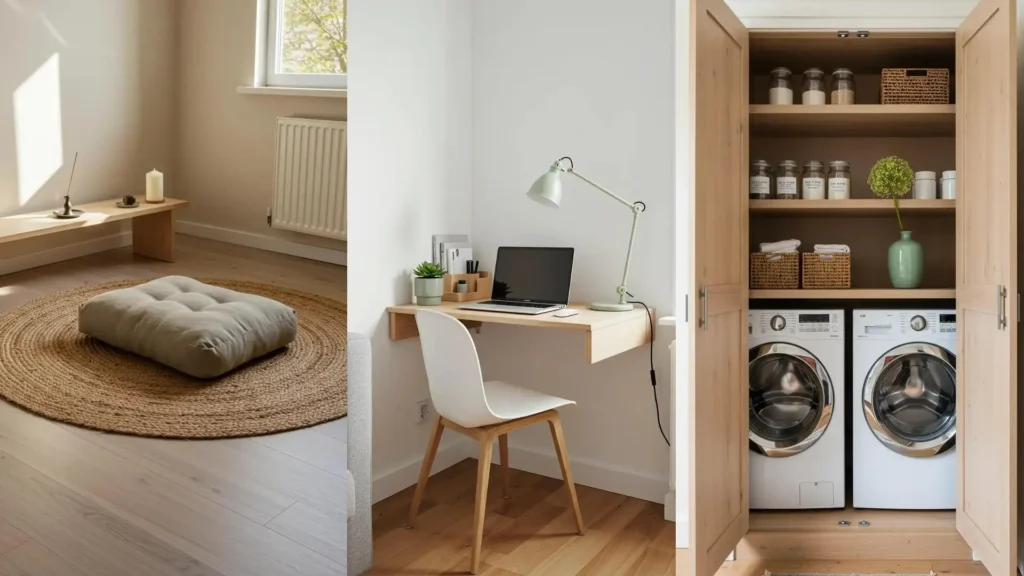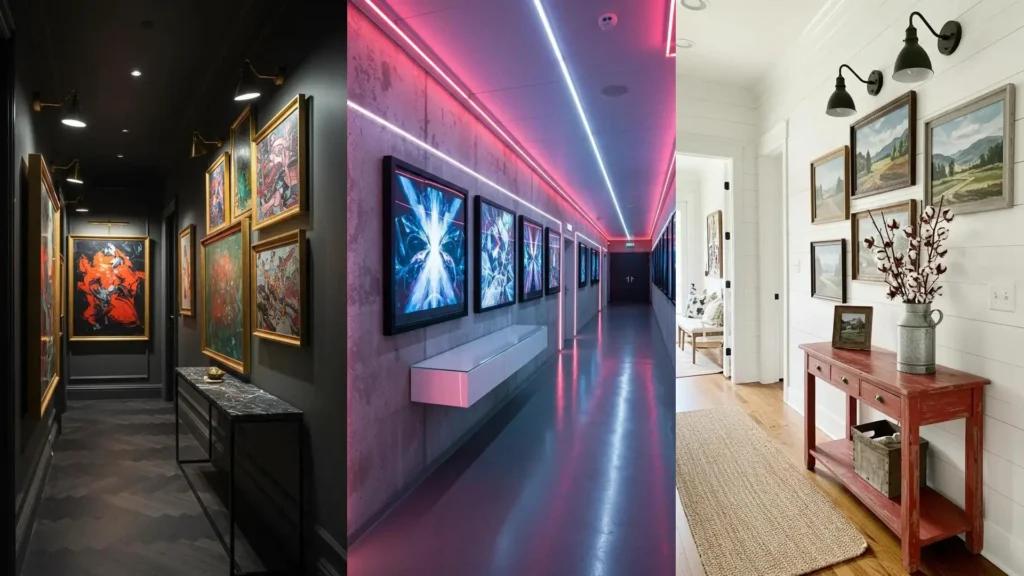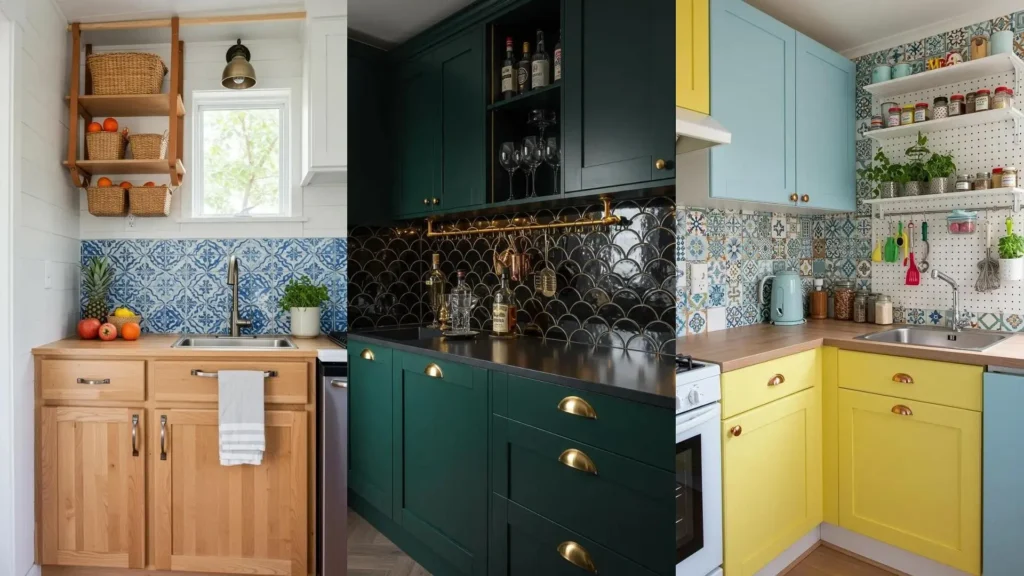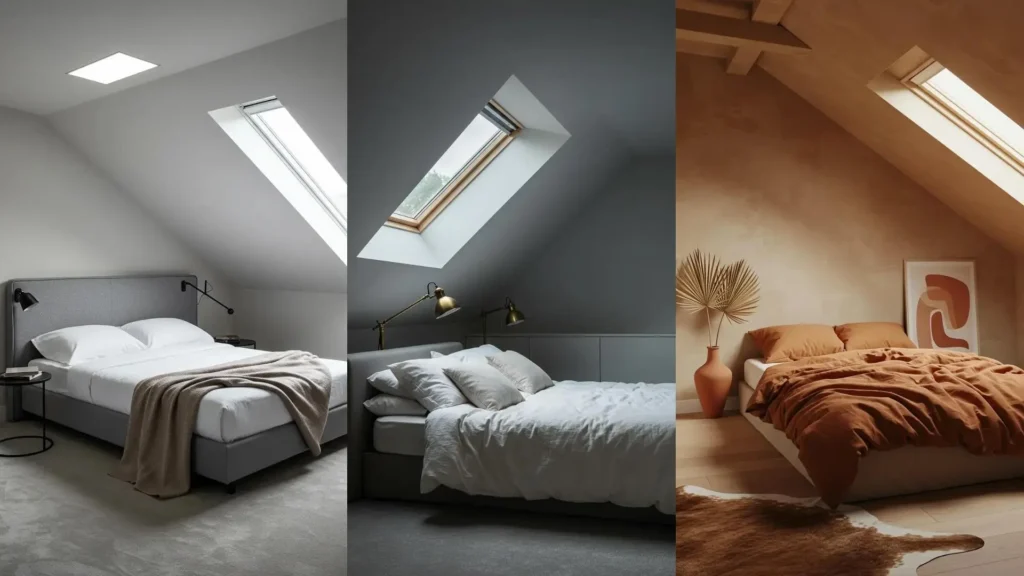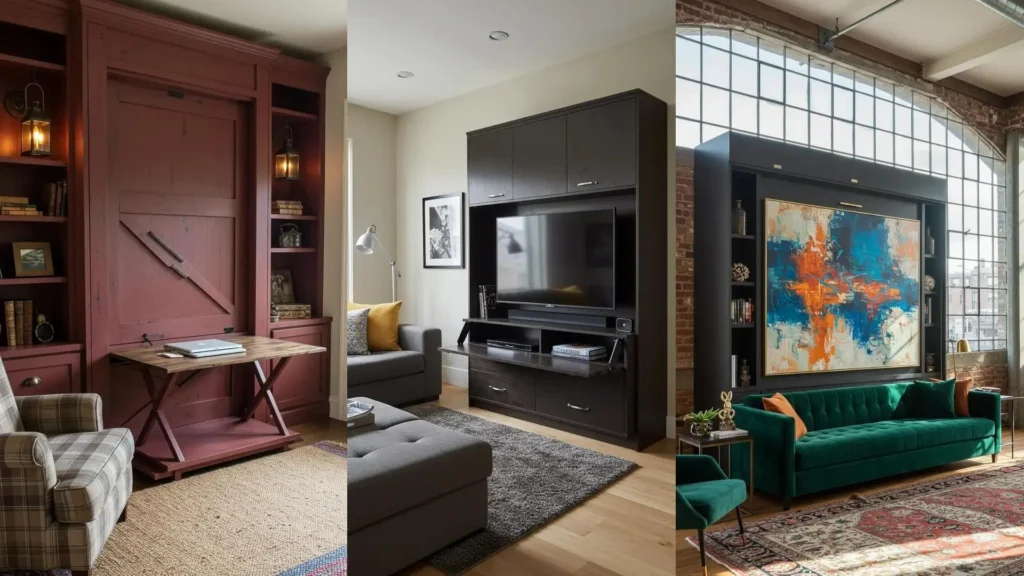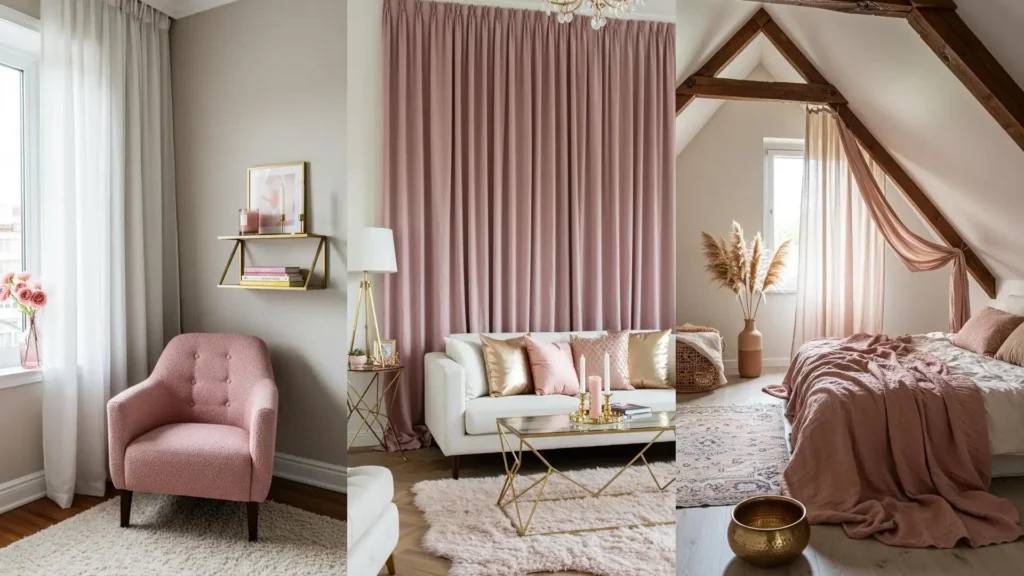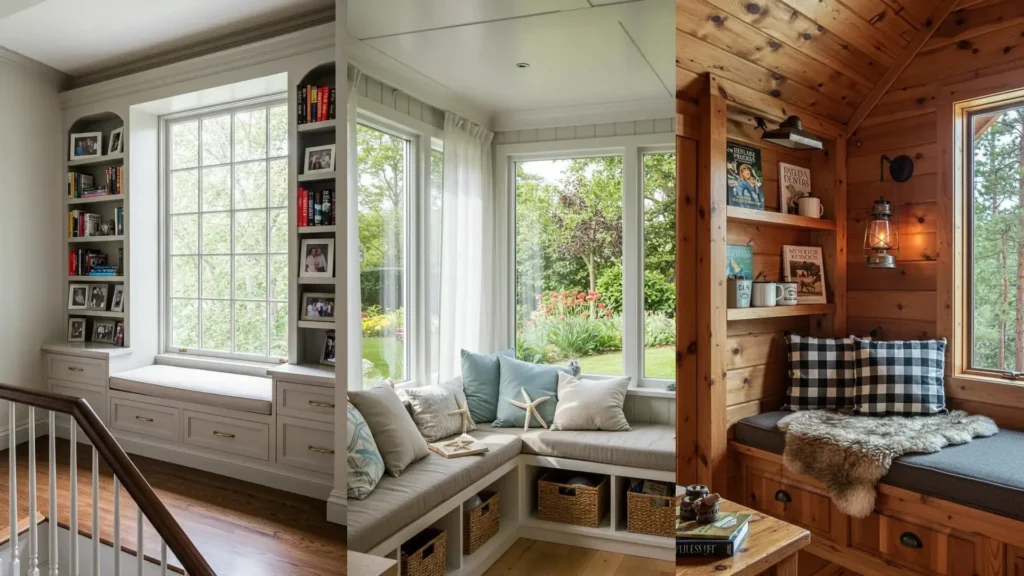Living in a small space doesn’t mean you have to compromise on serenity or style.
Often, the secret isn’t about having less, but about choosing pieces with more intention.
This is where the quiet power of light wood, the soft touch of linen, and the calming whisper of pale green come in. Together, they create a foundation that feels expansive, breathable, and deeply personal. It’s a palette that doesn’t shout for attention; it invites you to slow down and feel at home.
1. The Vertical Solution

Maximize every square foot by lifting your bed.
This creates a distinct zone for work or study below, instantly doubling the room’s functionality.
Choose a simple, light wood frame to keep the look airy, not bulky.
A single color for the bedding, like this soft sage green, unifies the upper level and adds a touch of calm.
This is one of the most effective ways to combine workspaces and living areas in a studio or dorm.
2. Unify with a Soothing Palette
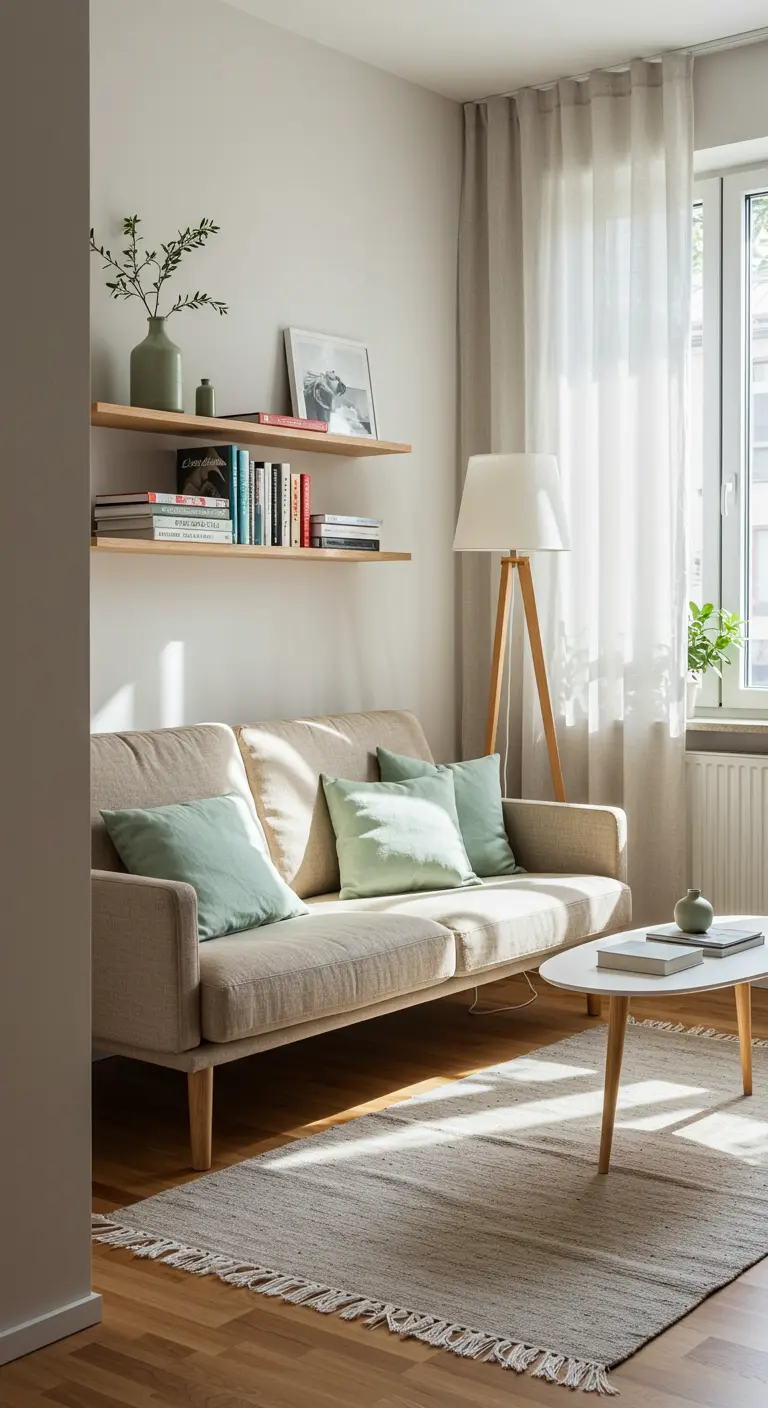
Create flow by repeating your core colors and materials.
Here, pale green cushions echo the color of the plant sprigs on the shelf, while the light wood of the sofa legs connects to the floor lamp and coffee table.
This subtle repetition makes the entire space feel cohesive and intentionally designed.
Use sheer linen curtains to soften the light without blocking it, enhancing the room’s gentle glow.
3. The Art of Restful Restraint
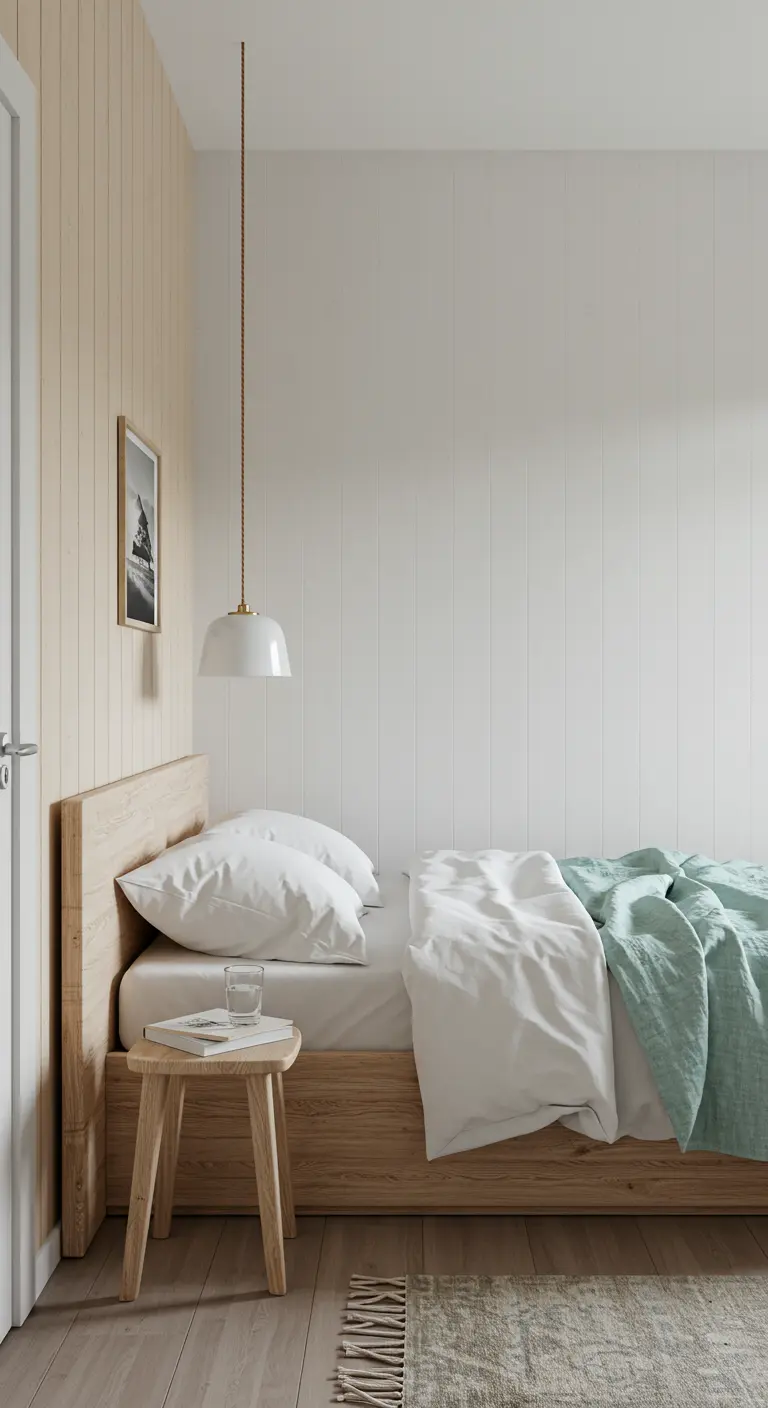
A serene bedroom often comes from editing, not adding.
A simple, low-profile wooden bed frame grounds the room without overwhelming it.
Pair it with crisp white linens and a single, rumpled duvet in your accent color for an effortlessly chic look.
One well-placed pendant light provides targeted illumination for reading and removes the need for a cluttered nightstand lamp.
This approach is key to creating calming interiors with washed woods.
4. Curate Your Open Shelving
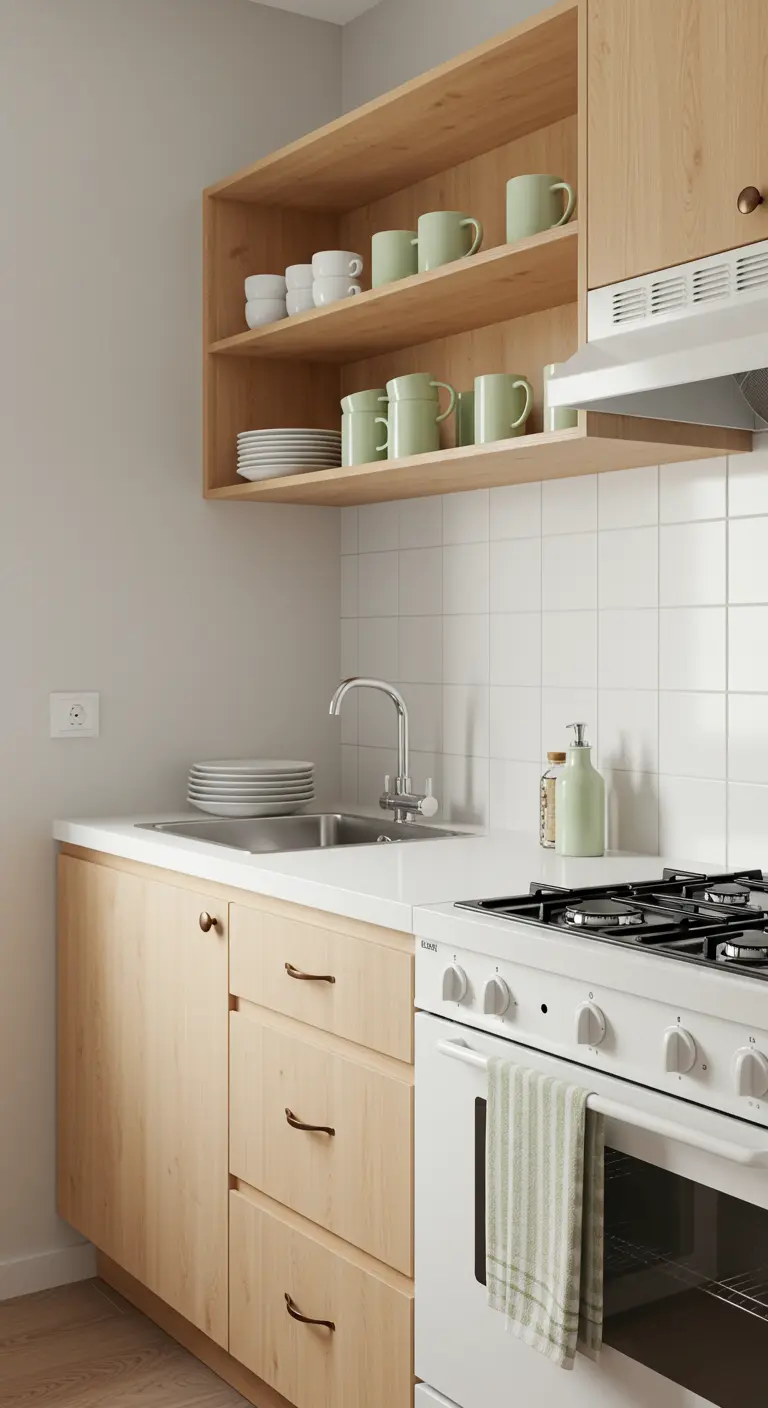
Open shelving can make a small kitchen feel larger, but it requires discipline.
Keep it from looking cluttered by sticking to a strict color palette—here, white plates and pale green mugs.
Stack items neatly and leave some breathing room.
This turns everyday essentials into a calm, decorative display.
For a more forgiving option, use a single open shelf for beautiful items and keep everything else in slimline storage behind closed doors.
5. Carve Out a Dedicated Corner
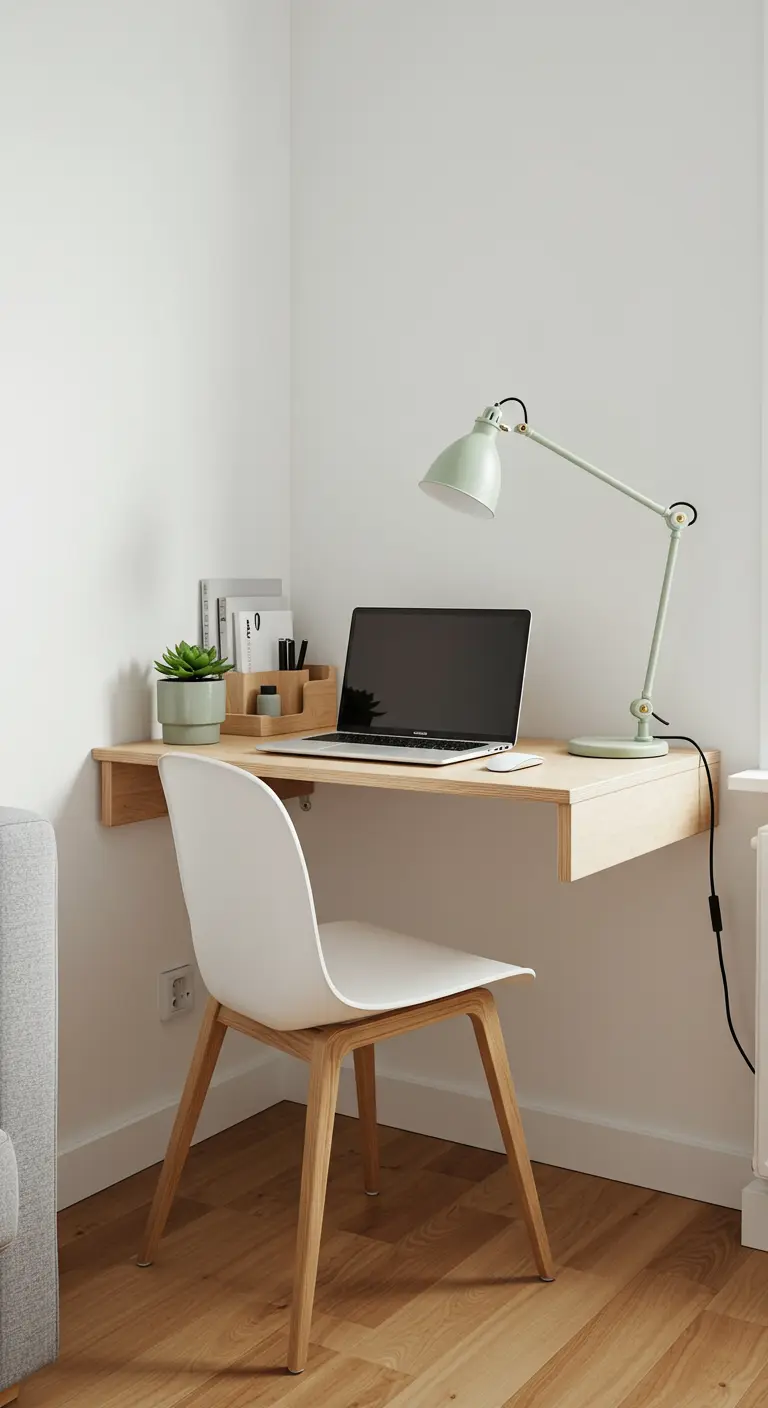
You don’t need a separate room for a functional office.
A simple floating shelf mounted in a corner creates a streamlined workspace that occupies minimal visual and physical space.
Choose a desk and chair with light wood elements to tie into your home’s overall palette.
A single, stylish task lamp in your accent color adds personality and focused light.
6. Set a Serene First Impression
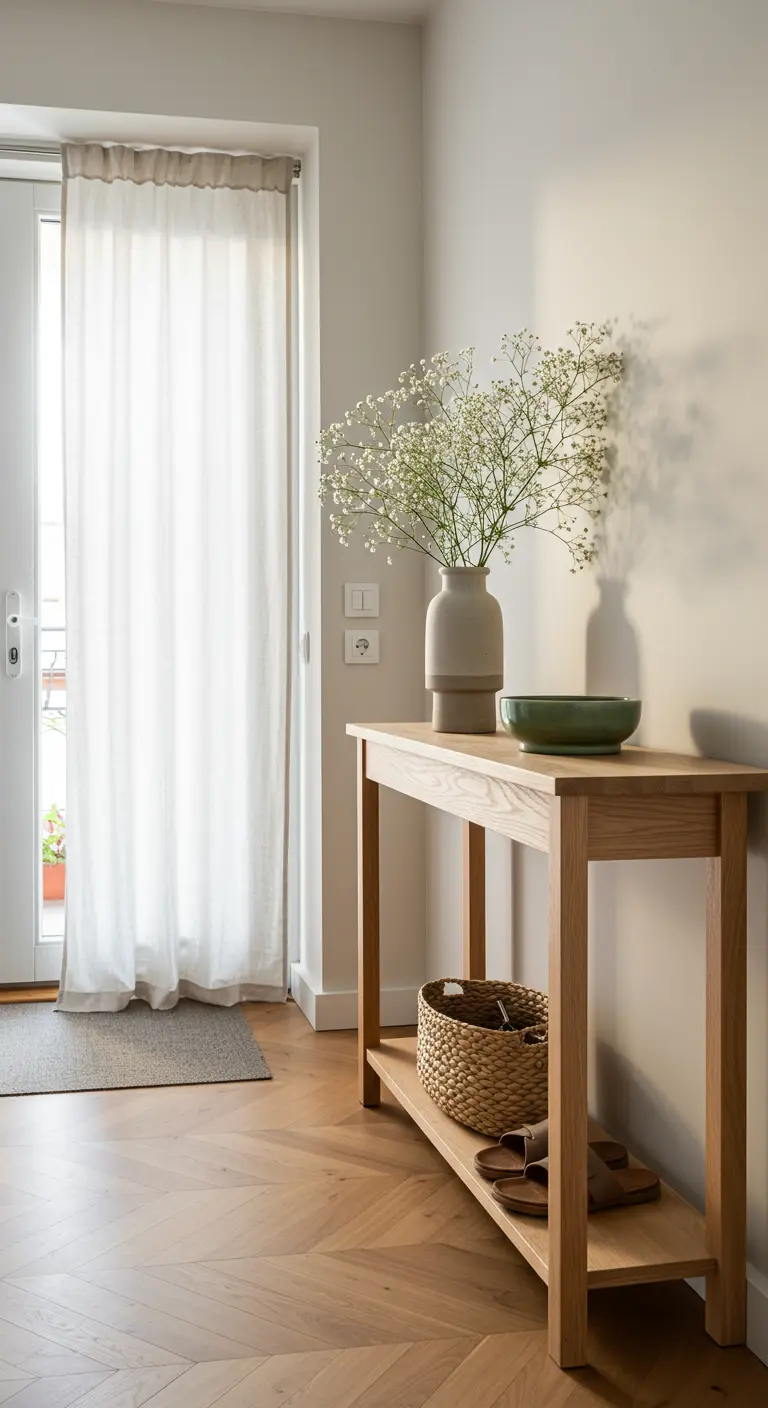
Your entryway establishes the mood for your entire home.
Keep it simple and uncluttered with a slim console table in a warm, light wood.
The lower shelf offers a practical spot for shoes or a woven basket for storage, keeping the floor clear.
A single vase with delicate branches, like baby’s breath, adds life without adding visual noise.
The herringbone wood floor adds a layer of subtle, sophisticated pattern.
7. Build In for Intimacy and Storage
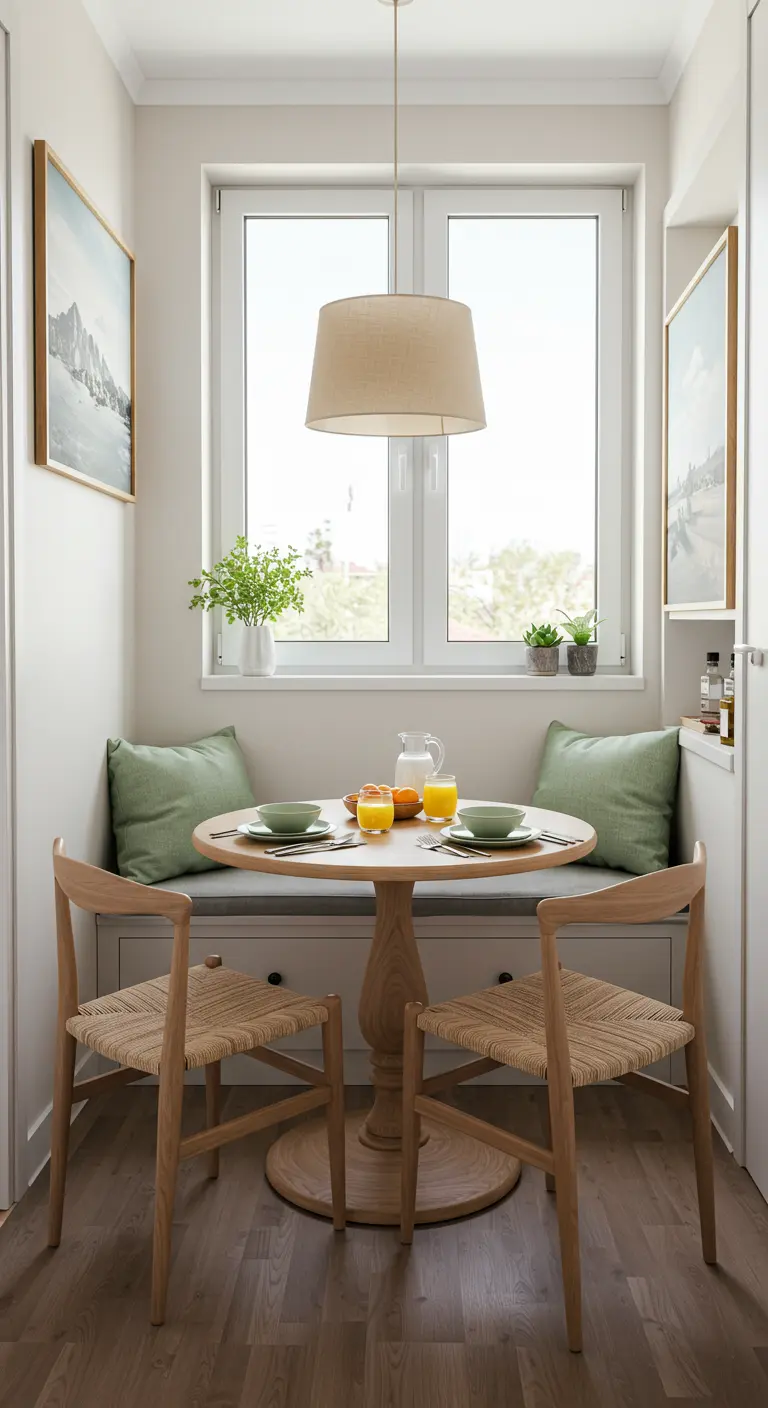
A built-in banquette is a brilliant space-saver that turns a corner into a cozy dining destination.
The bench seating can be built with drawers or a lift-up top for hidden storage—perfect for stashing seasonal linens or small appliances.
Pair it with a round pedestal table, which has no sharp corners and allows for easier movement.
Soft linen pillows in your accent green make the nook comfortable and inviting.
8. Layer Textures for Warmth
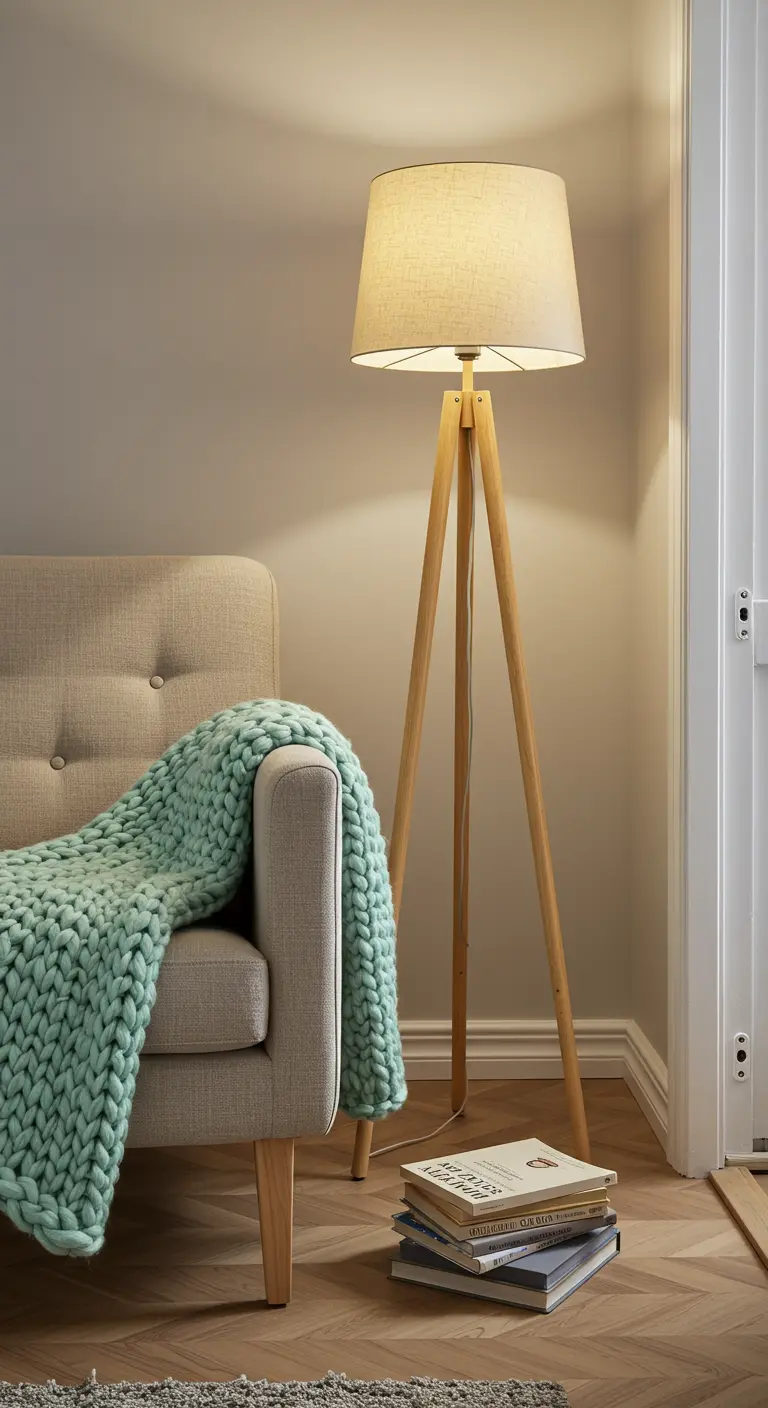
A neutral palette comes alive with varied textures.
Contrast the smooth weave of the sofa upholstery with a dramatically chunky knit throw.
This simple addition invites touch and adds a deep sense of comfort and visual interest.
The tripod floor lamp in natural wood adds another textural element, while a stack of books provides a lived-in, intellectual touch that feels more authentic than typical decor objects.
9. Add Life to a Clean Palette
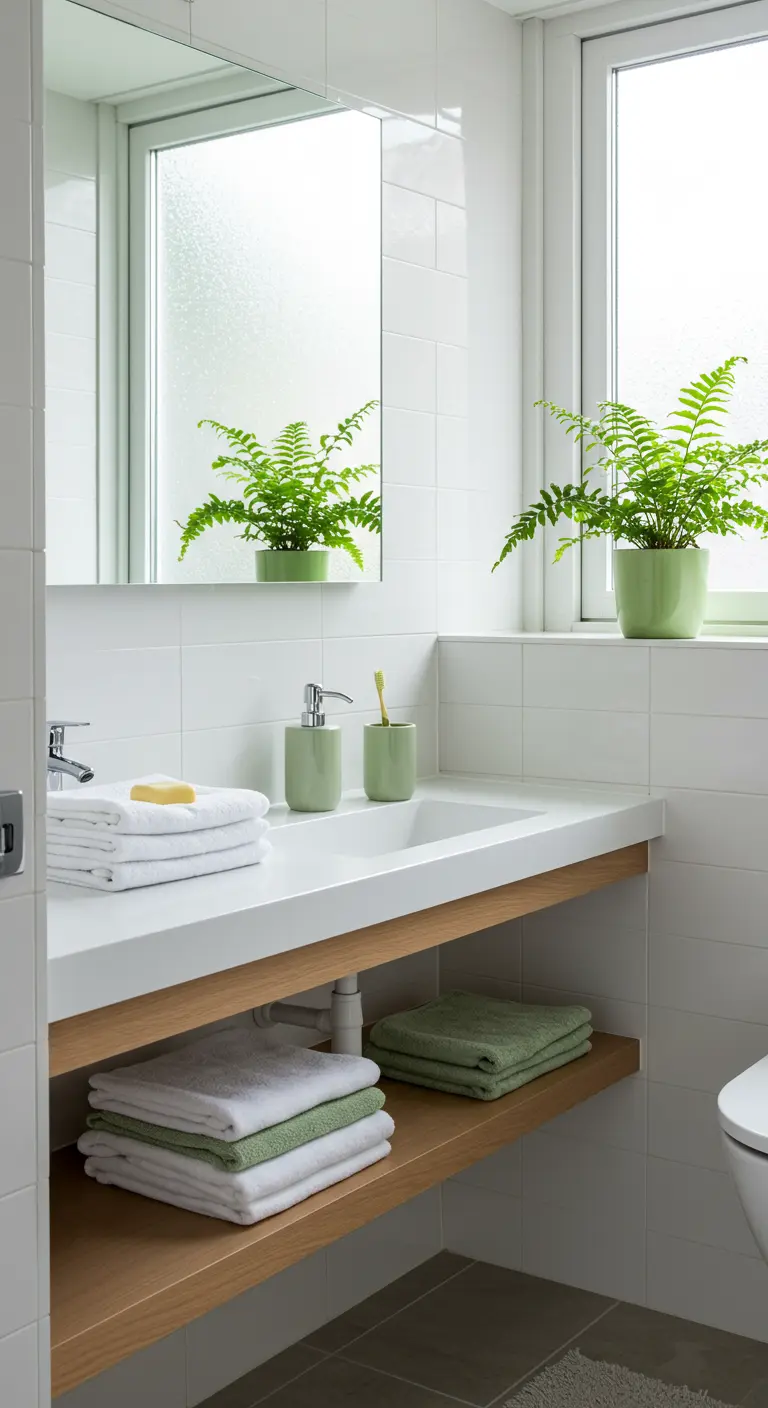
In an all-white bathroom, a floating wood shelf adds immediate warmth and an organic feel.
It also provides open, accessible storage for neatly folded towels.
Use your accent color in small, repeatable doses—like the soap dispenser, tumbler, and towels—to create a cohesive look.
A potted fern thrives in the humidity and adds a vibrant, living green that purifies the air and the aesthetic.
10. Create a Small Outdoor Escape

Treat your balcony as an extension of your living space.
Interlocking wood deck tiles are a simple, renter-friendly way to cover concrete and add warmth.
A foldable bistro set provides seating without committing to bulky furniture.
Use rail planters to grow herbs or flowers, drawing the eye upward and freeing up floor space for a potted plant or two.
It’s one of the simplest chic balcony displays you can create.
11. Embrace Architectural Character
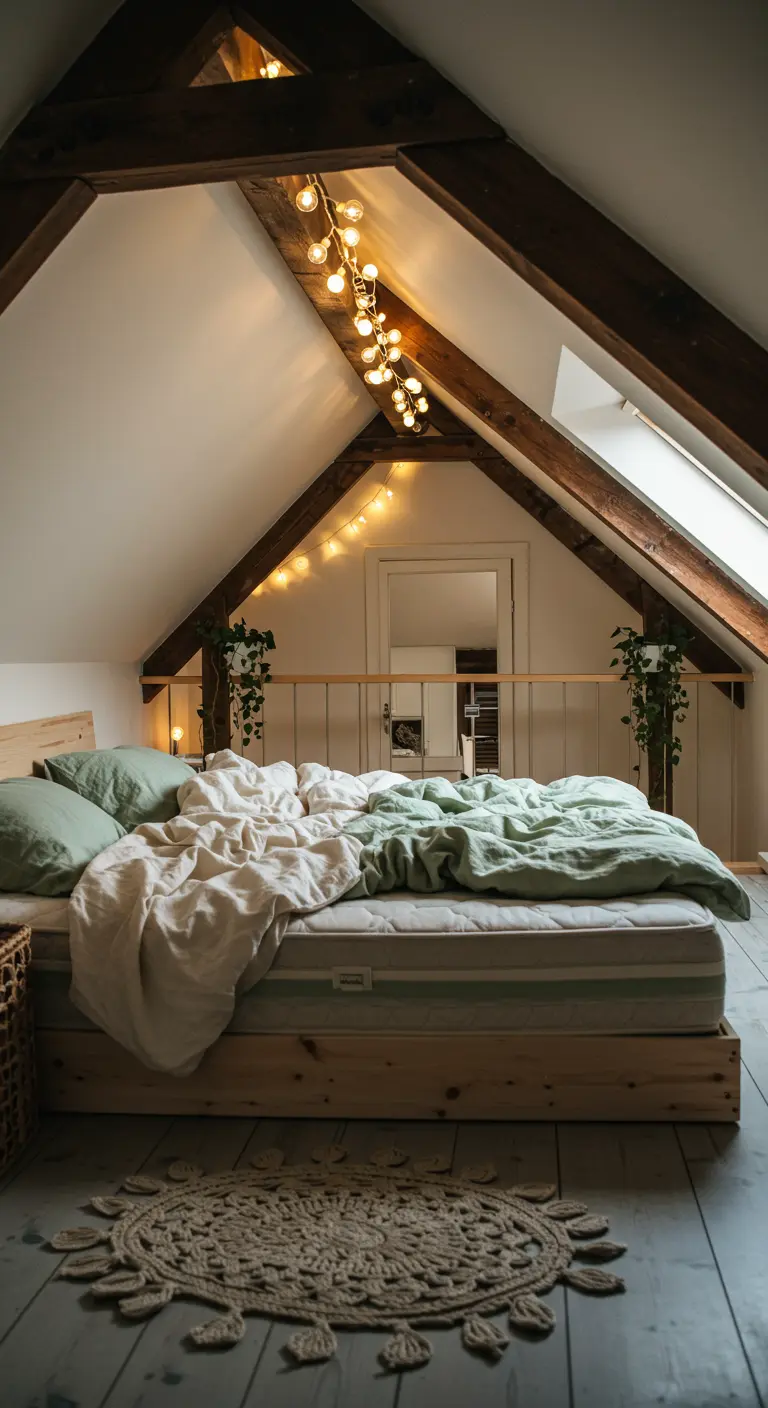
Don’t fight against slanted ceilings or exposed beams—celebrate them.
Keep the bed low to the ground to maximize headroom and create a cozy, den-like feeling.
Drape string lights along the beams for soft, ambient lighting that enhances the room’s unique shape.
Using rumpled linen bedding in pale, earthy tones adds to the relaxed, rustic vibe.
This creates a wonderful rustic cabin bedroom retreat.
12. The Open-Concept Divider
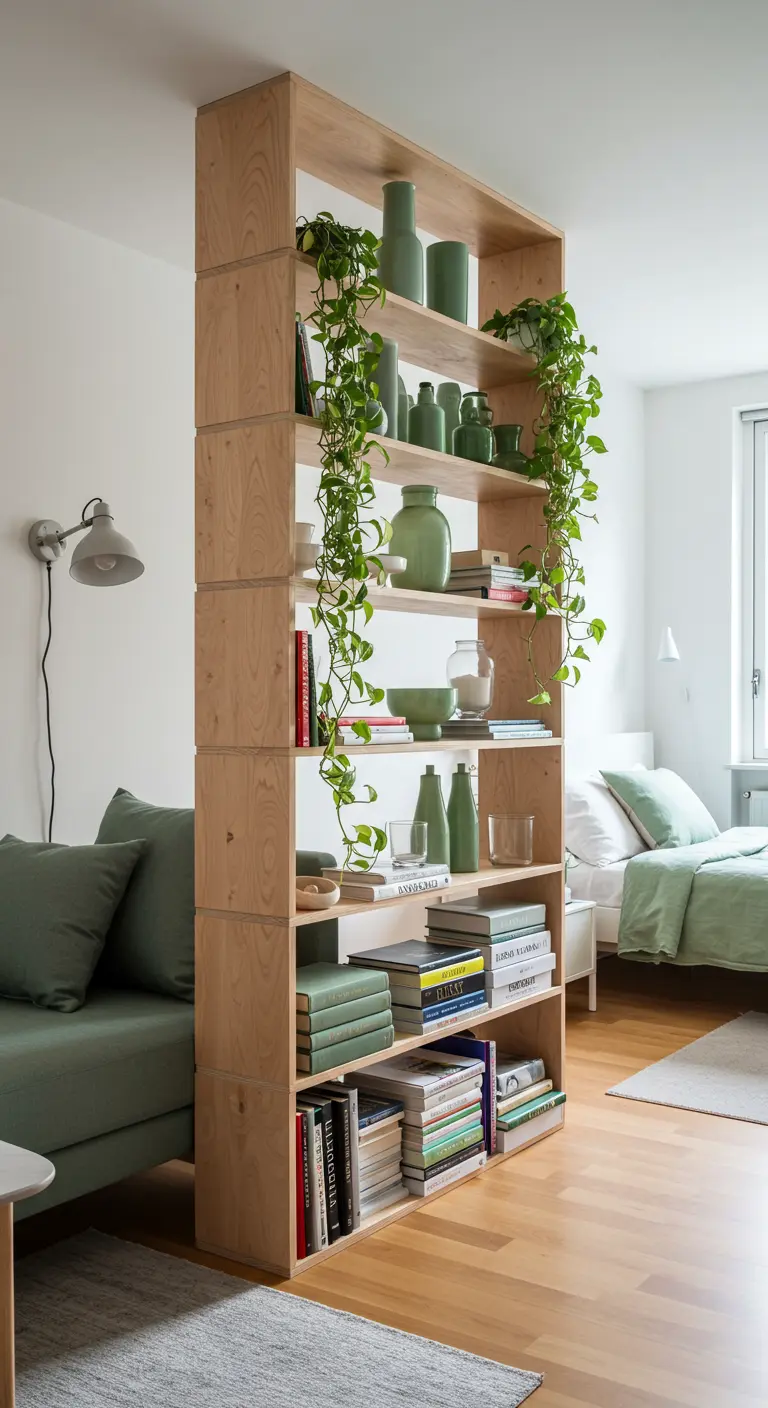
In a studio or open-plan apartment, a tall, open-backed bookshelf is the perfect room divider.
It separates living and sleeping areas while allowing light and air to flow through, preventing the space from feeling boxed in.
Style it with books, ceramics in your accent color, and cascading plants to turn it into a living, breathing feature wall.
This is one of the smartest ways to define spaces in small apartments.
13. Design a Purposeful Pause
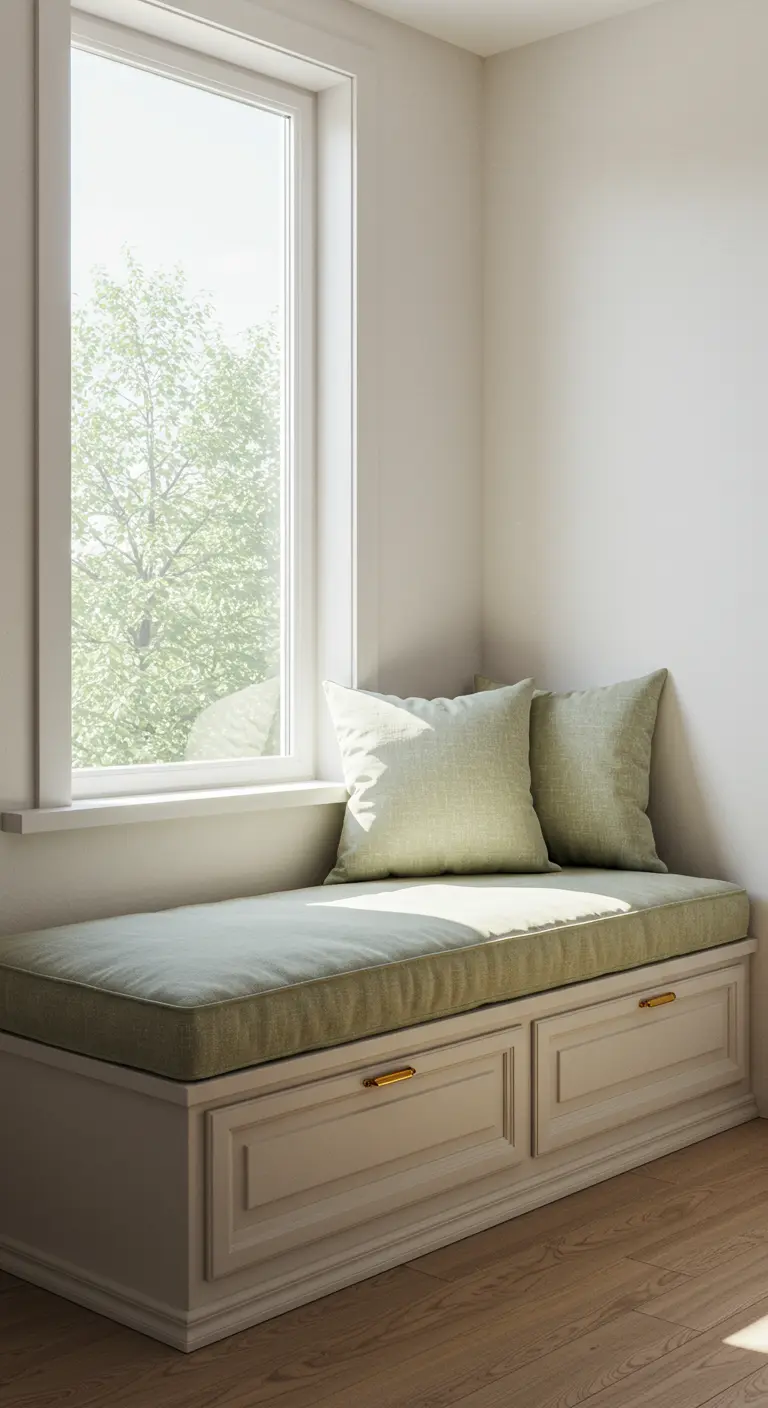
Transform an awkward nook or the space under a window into a destination.
A custom-built window seat with integrated drawers below offers both comfortable seating and valuable storage.
A thick, upholstered cushion in a durable fabric makes it the perfect spot for reading or enjoying a morning coffee.
The simple paneled drawer fronts and minimalist hardware keep the look clean and timeless.
14. Elongate with Clean Lines

In a narrow galley kitchen, guide the eye forward to create a sense of spaciousness.
A continuous wood countertop and long, horizontal lines in the backsplash tile achieve this effect.
Light-colored upper and lower cabinets prevent the space from feeling heavy.
Here, the glossy, pale green subway tile adds a pop of color and reflects light, making the kitchen feel brighter and wider than it is.
It’s a hallmark of beautiful pastel-hued kitchens.
15. Organize for Calm
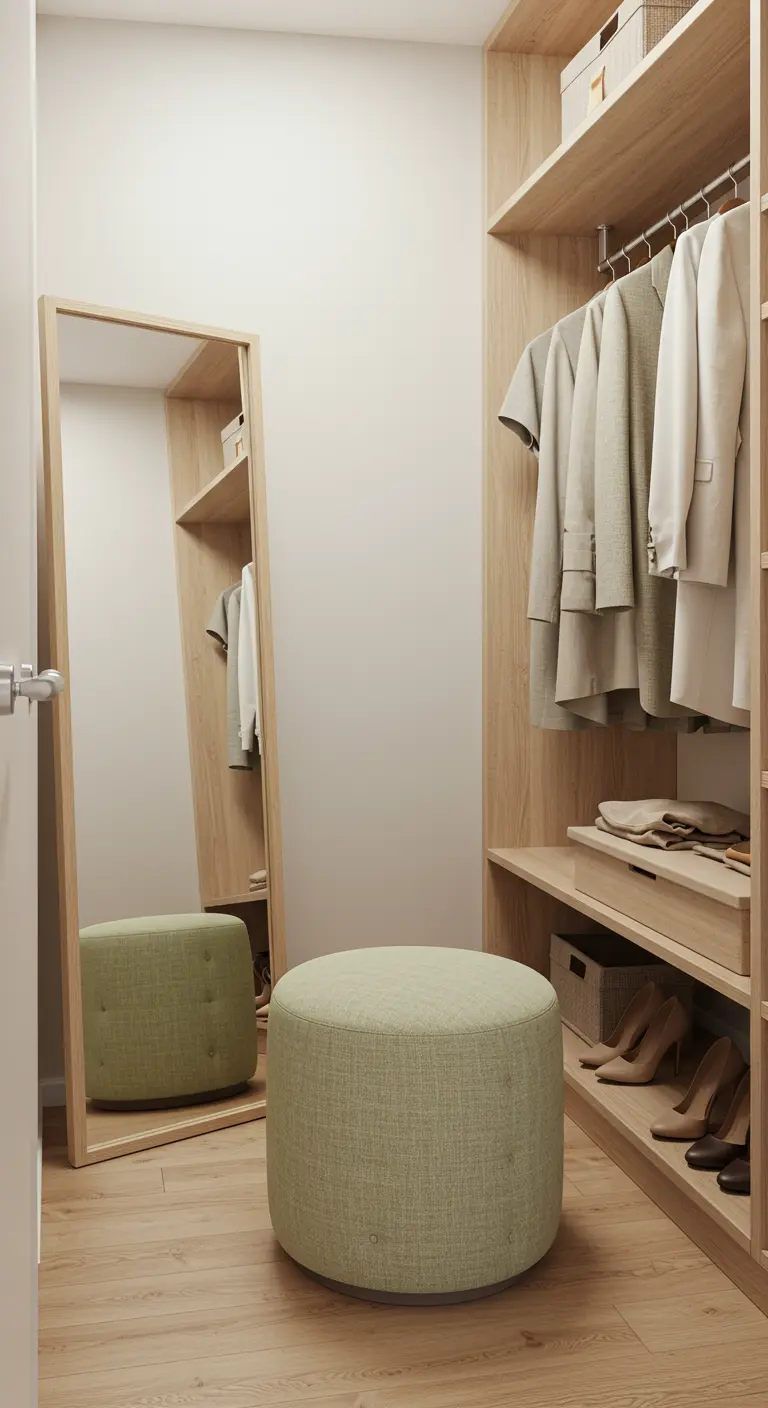
A well-organized closet is a form of self-care.
Use light wood shelving to create a warm, boutique-like feel.
Edit your wardrobe so that only the pieces you love are on display; this reduces visual clutter and makes getting dressed a more pleasant experience.
A simple, full-length mirror leans against the wall to make the space feel larger, while a round, upholstered ottoman in a soft green provides a comfortable spot to sit.
16. Open Up with a Bar
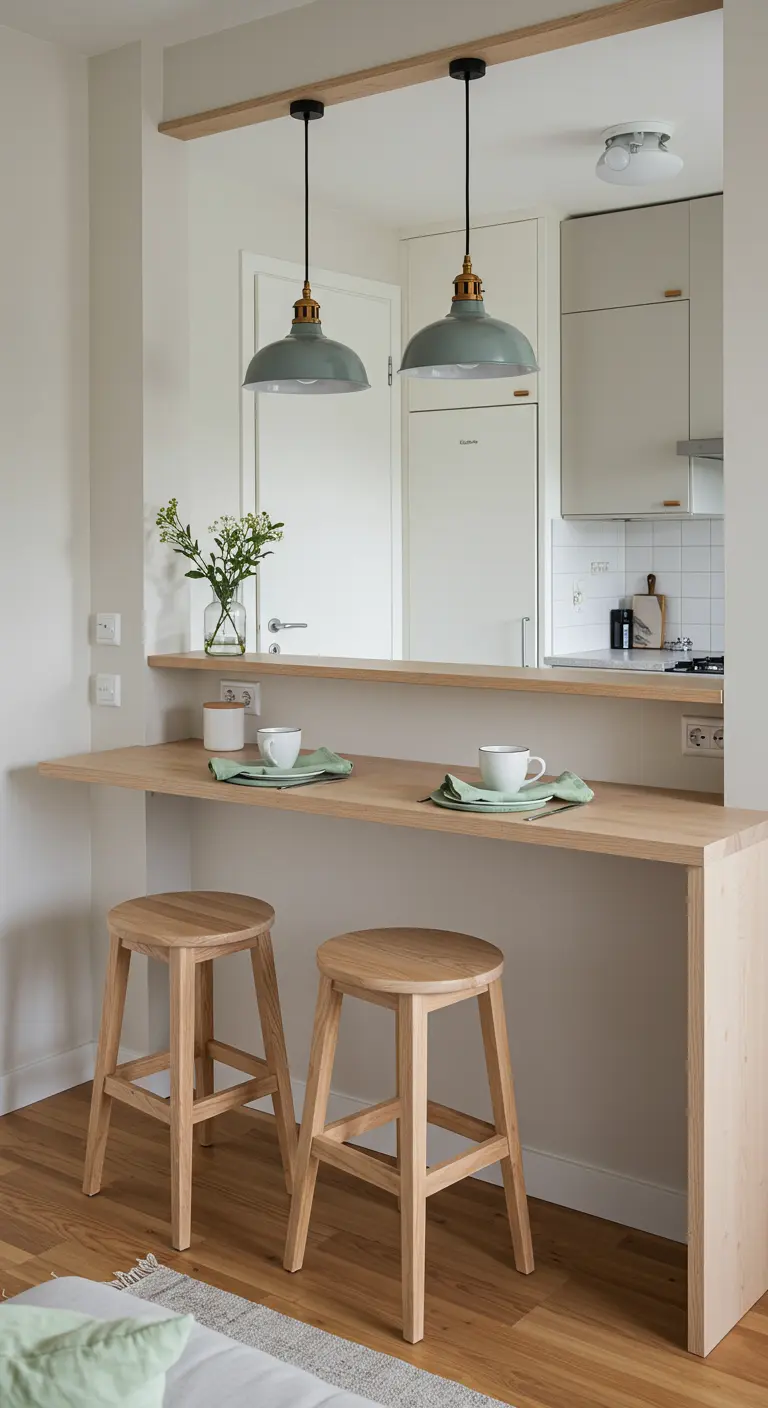
A pass-through or breakfast bar is an excellent way to connect a kitchen to a living or dining area, enhancing the sense of space and sociability.
A solid wood countertop creates a warm and durable surface for quick meals or conversations.
Hanging a pair of stylish pendant lights above defines the zone and provides functional task lighting.
These lighting tricks expand tiny interiors beautifully.
17. Choose Furniture That Multitasks

In a small living area, a daybed is a brilliant, flexible piece.
It serves as a comfortable sofa for lounging and entertaining, but can easily become a guest bed when needed.
Pile on pillows in various sizes and textures—linens, cottons, and wovens—in your chosen color palette to create a deep, inviting look.
A large plant in a woven basket adds life and balances the horizontal line of the furniture.
18. Anchor with a Grounding Rug

Use a rug to define the seating area and anchor your furniture, making the arrangement feel intentional.
In a room with wood floors, choose a rug with a subtle pattern and soft texture to add warmth and prevent the wood tones from feeling monotonous.
Position at least the front legs of your sofa and chairs on the rug to create a cohesive grouping.
The pale sage sofa here provides just enough color to be interesting without overpowering the serene scheme.
19. Let Art Set the Tone

Instead of a headboard, use a large piece of abstract art to create a focal point above the bed.
Choose a piece with colors that reflect your palette—like the soft greens and beiges here—to tie the room together.
Frame it in a simple, light wood to match your other furniture.
This approach adds a sophisticated, personal touch and draws the eye upward, making the ceiling feel higher.
It’s a simple way to create a botanical green bedroom retreat.
20. Group Plants for Impact
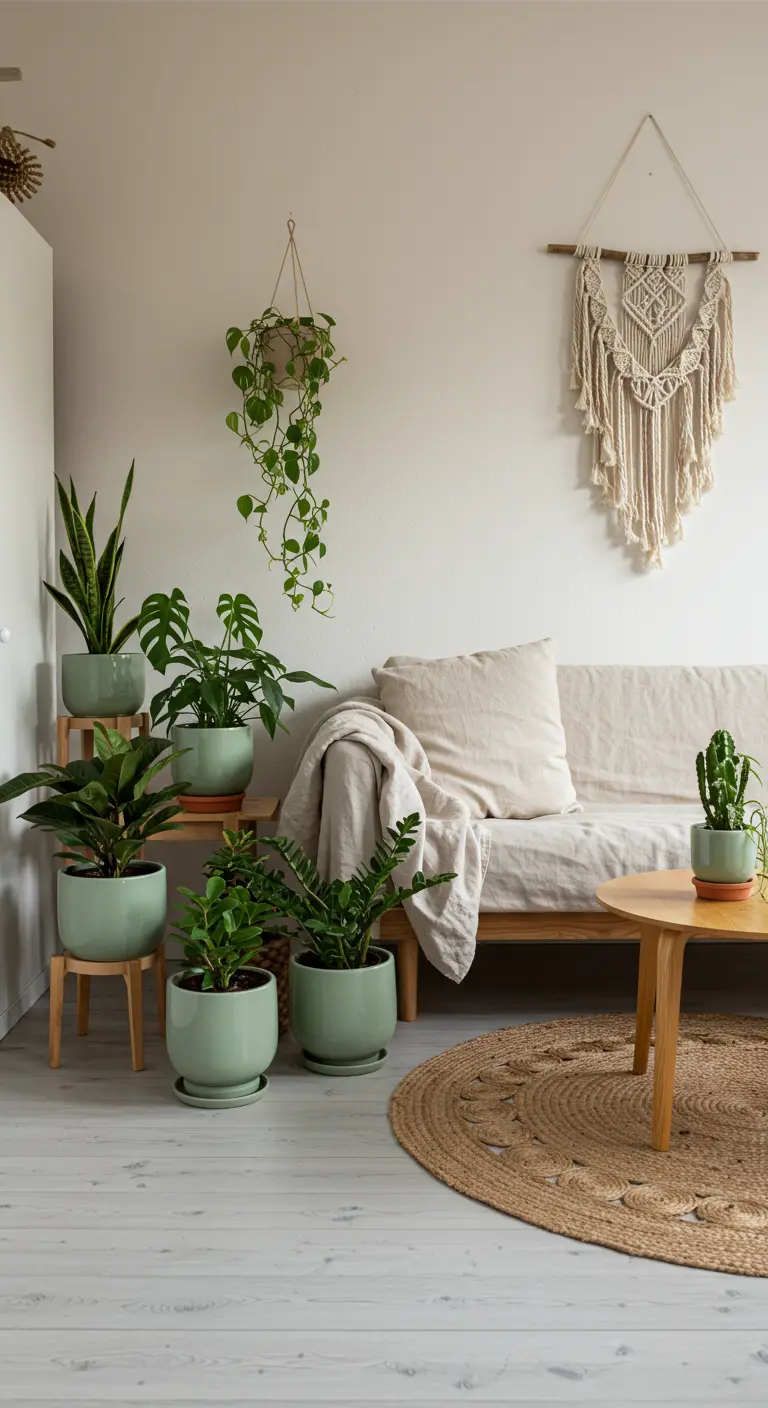
A single plant is nice, but a curated group creates a lush, jungle-like statement.
Vary the height and leaf shape of your plants, and cluster them together in a corner to create a vibrant green moment.
Use simple, coordinating pots—like these matte pale green ceramic ones—to keep the look unified rather than chaotic.
This creates compact rooms with garden vibes and improves air quality.
21. Hide Utility with Style

A laundry area doesn’t have to be an eyesore.
Conceal your washer and dryer within a custom floor-to-ceiling cabinet.
Simple light wood doors blend seamlessly with a warm, minimalist aesthetic, hiding the machinery when not in use.
Inside, open shelving provides practical, organized storage for detergents and supplies, turning a purely functional space into a design feature.
22. Make Transitional Spaces Matter
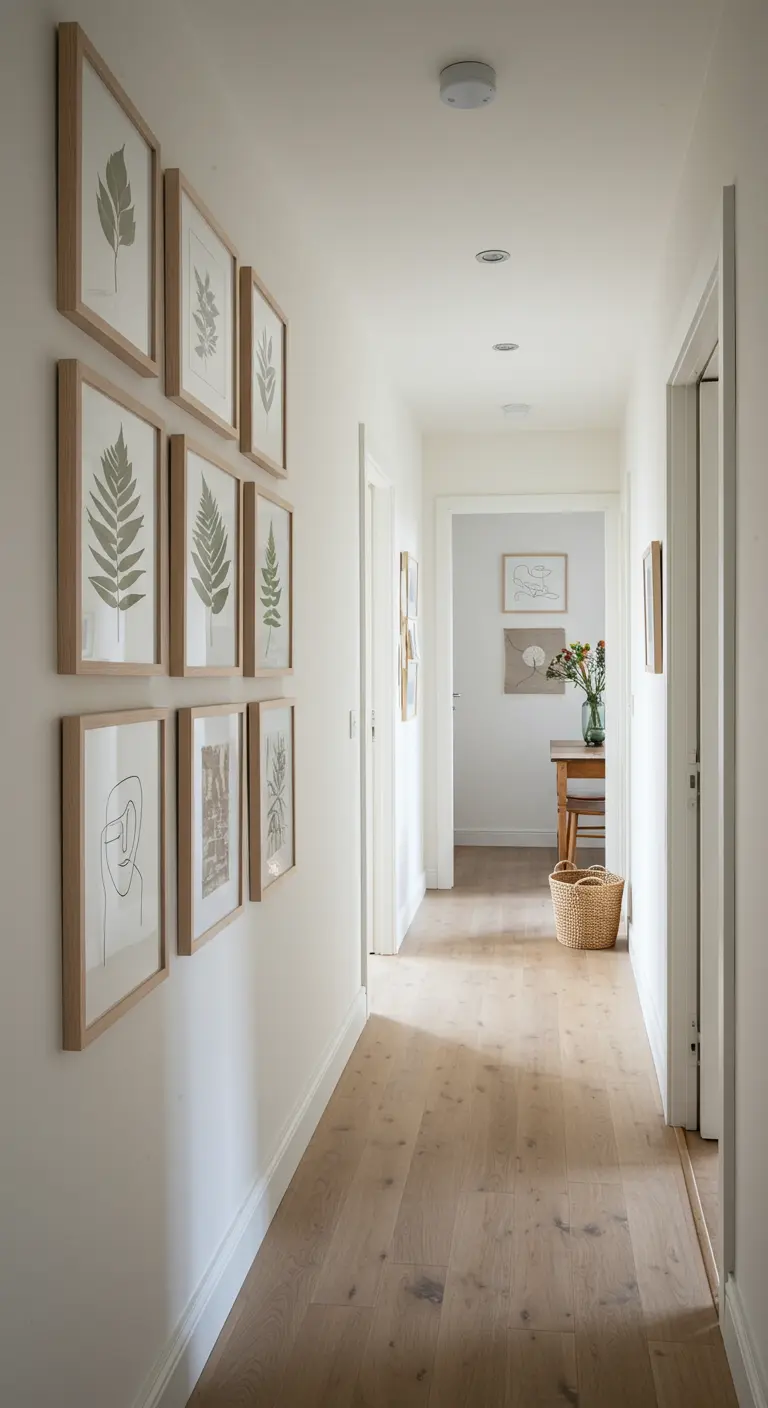
Don’t neglect your hallways.
A well-executed gallery wall can turn a simple passageway into a point of interest.
Create cohesion by using identical frames, like these simple light wood ones.
The repetition provides structure, allowing you to mix and match different prints within.
A series of botanical illustrations in green and black reinforces your color scheme and adds a natural, calming theme.
23. Add Depth Beyond Color
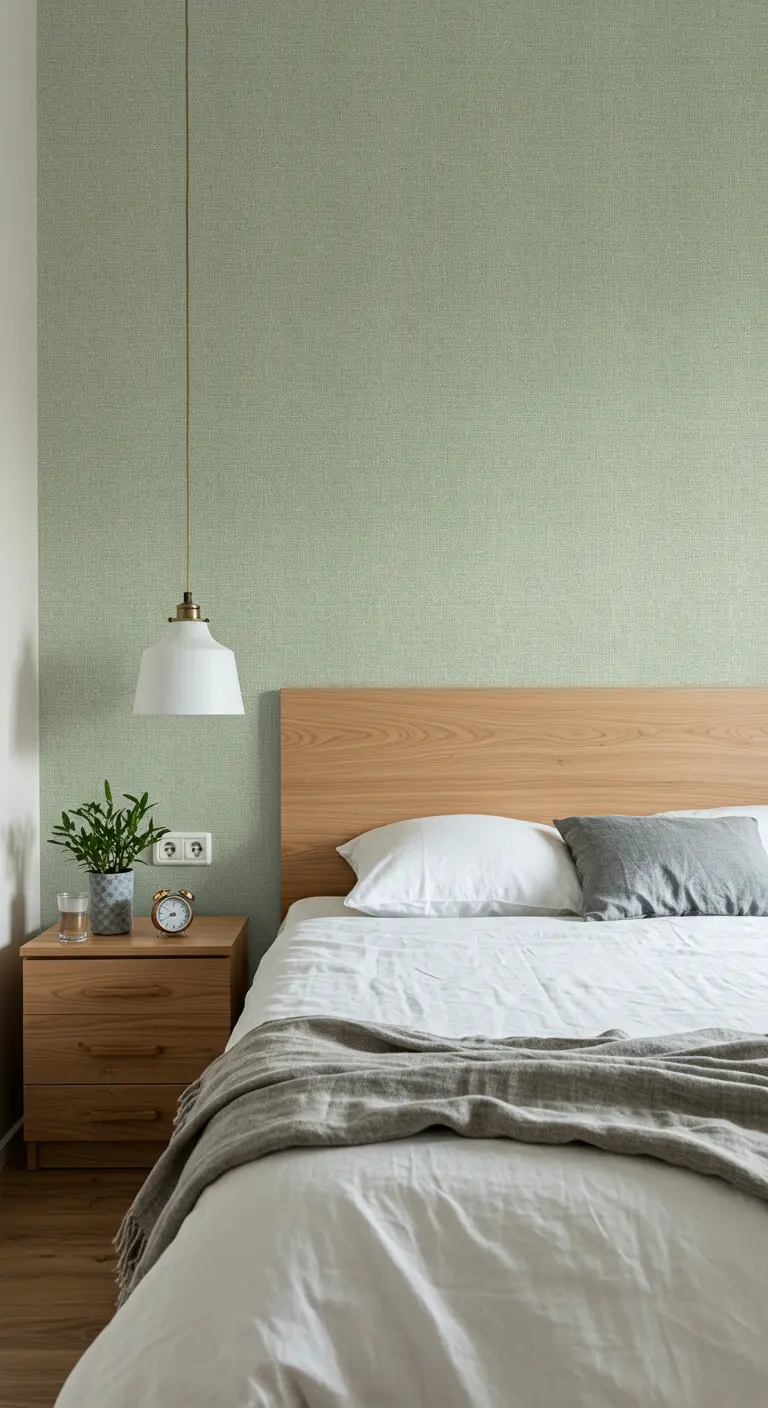
An accent wall doesn’t have to be a bold, flat paint color.
A textured wallcovering, like this pale green grasscloth, adds incredible depth, warmth, and sophistication.
The subtle variations in the weave catch the light beautifully and provide a rich backdrop for simple furnishings.
Pair it with a low, clean-lined wood headboard to let the texture remain the star.
24. Adapt Your Dining Space
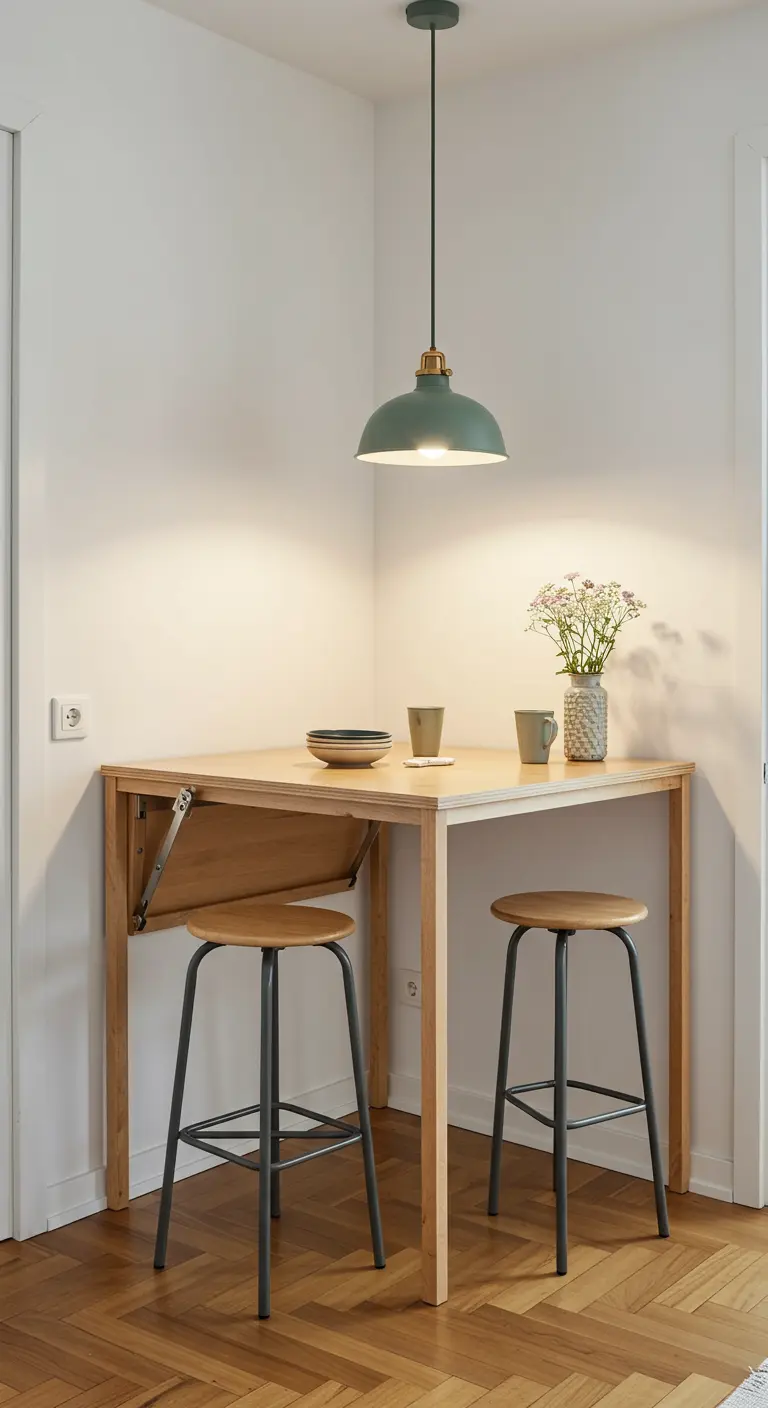
A drop-leaf table is the ultimate solution for small-space dining.
Keep one or both leaves down for daily use, creating a slim console-like surface.
When guests arrive, simply lift the leaves to create a full-sized dining table.
This piece offers maximum flexibility, adapting to your needs from moment to moment.
A single pendant light centered above ensures the space is always well-lit, whether the table is large or small.
25. Customize Your Organization
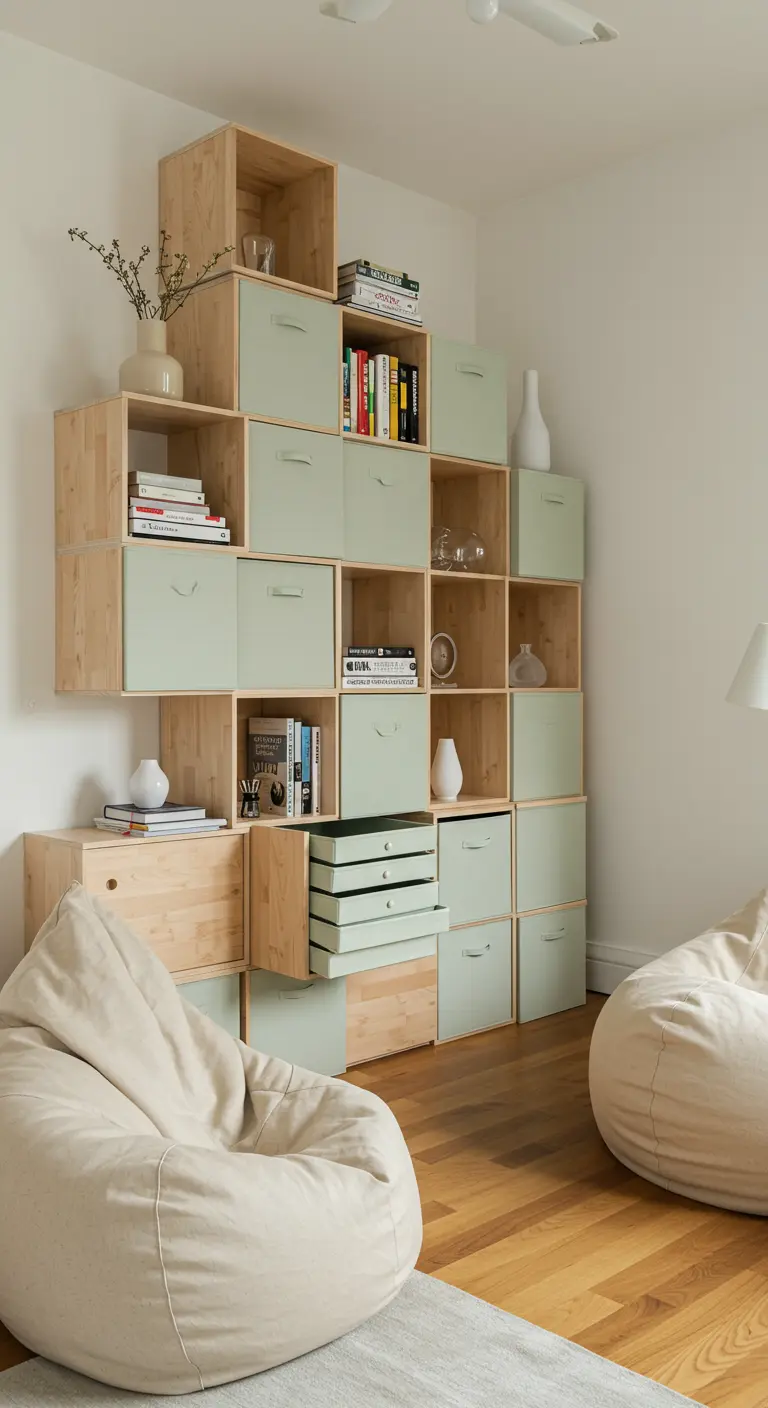
Modular cube storage is a versatile and scalable solution for any room.
You can stack and arrange the cubes to fit your exact space and needs.
Intersperse open cubes for displaying books and decor with closed bins or doors—in your pale green accent color—to hide clutter.
This creates a playful, graphic look that is also incredibly practical for keeping a small space tidy.
It’s a great foundation for stylish multipurpose rooms.
26. Designate a Space for Stillness
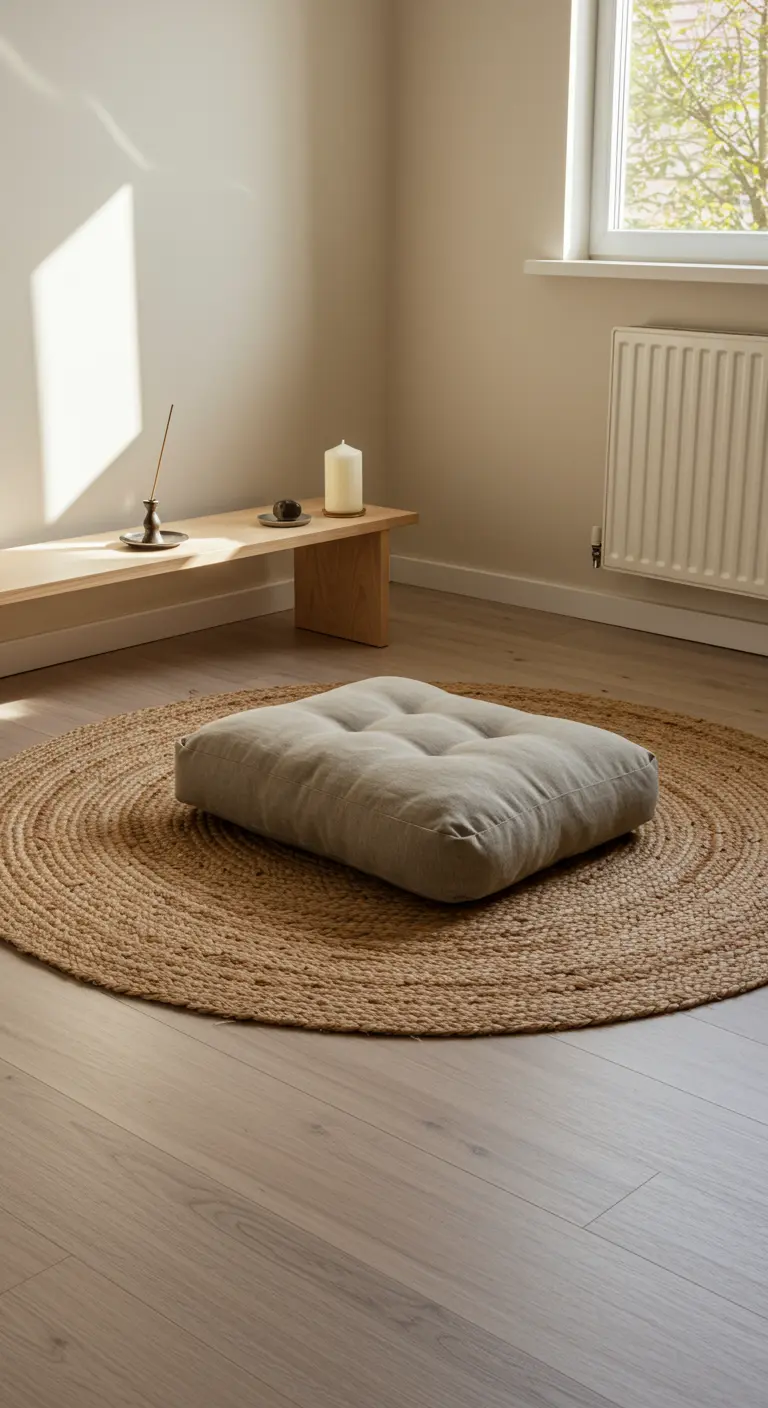
You don’t need a large area to create a space for meditation or quiet reflection.
A simple corner will do.
Define the spot with a round, natural jute rug, which adds texture and delineates the zone.
A low wooden bench can hold a candle or incense, while a single tufted floor cushion provides comfortable seating.
This approach beautifully embodies the principles of serene Japandi interiors.
27. Demand More from Your Furniture

In a compact room that needs to serve multiple functions, choose furniture that works twice as hard.
This daybed not only provides seating and sleeping space but also includes deep, integrated drawers for substantial storage.
Pairing it with a slim, C-shaped table that can slide over the mattress creates a perfect perch for a laptop or a cup of tea without needing a separate side table.
It’s a perfect example of design for tiny homes with Scandinavian calm.
28. Filter, Don’t Block, the Light
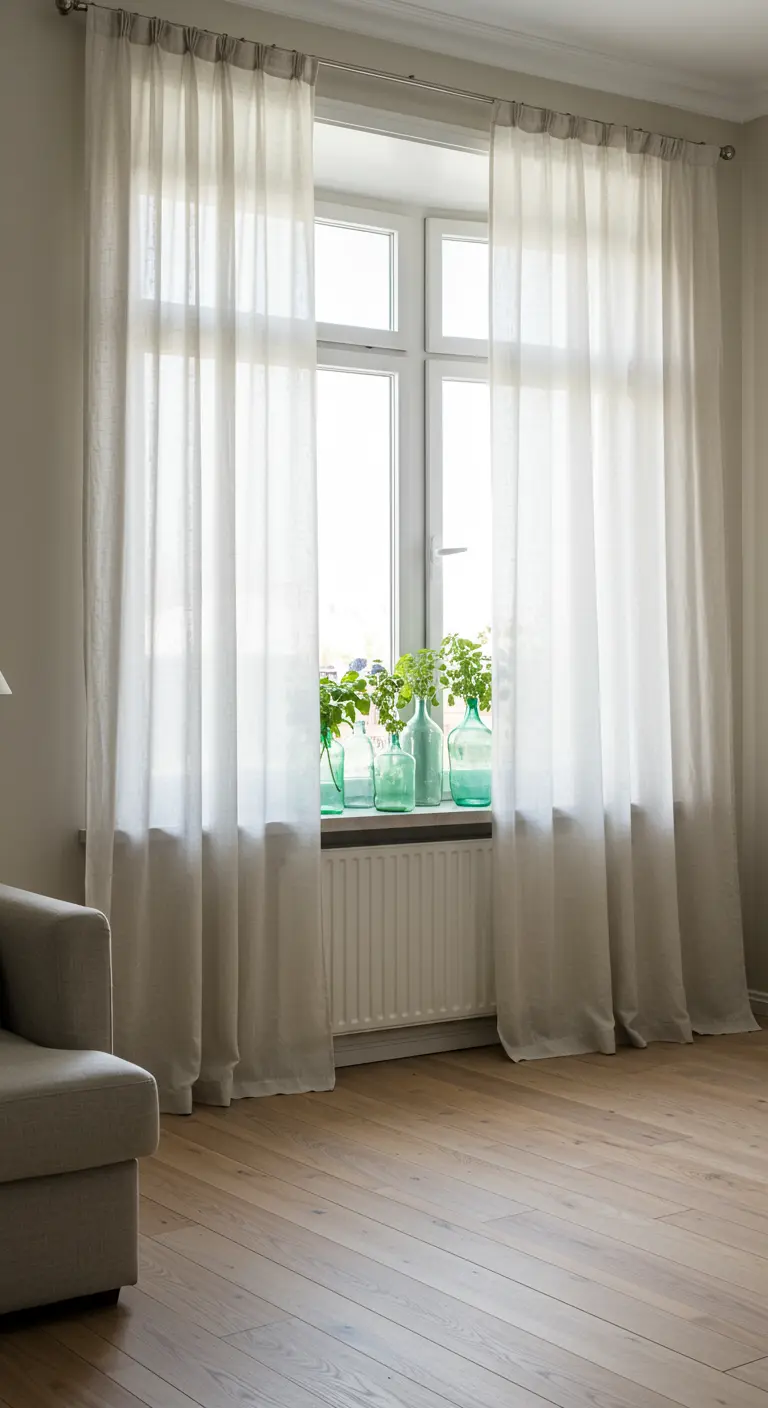
Heavy, opaque curtains can make a small room feel dark and cave-like.
Instead, opt for lightweight, sheer linen curtains.
They provide privacy while allowing soft, diffused natural light to fill the space, creating an airy, ethereal glow.
Hang the curtain rod high and wide—extending beyond the window frame—to create the illusion of a larger, grander window.
29. Float Your Vanity for Space
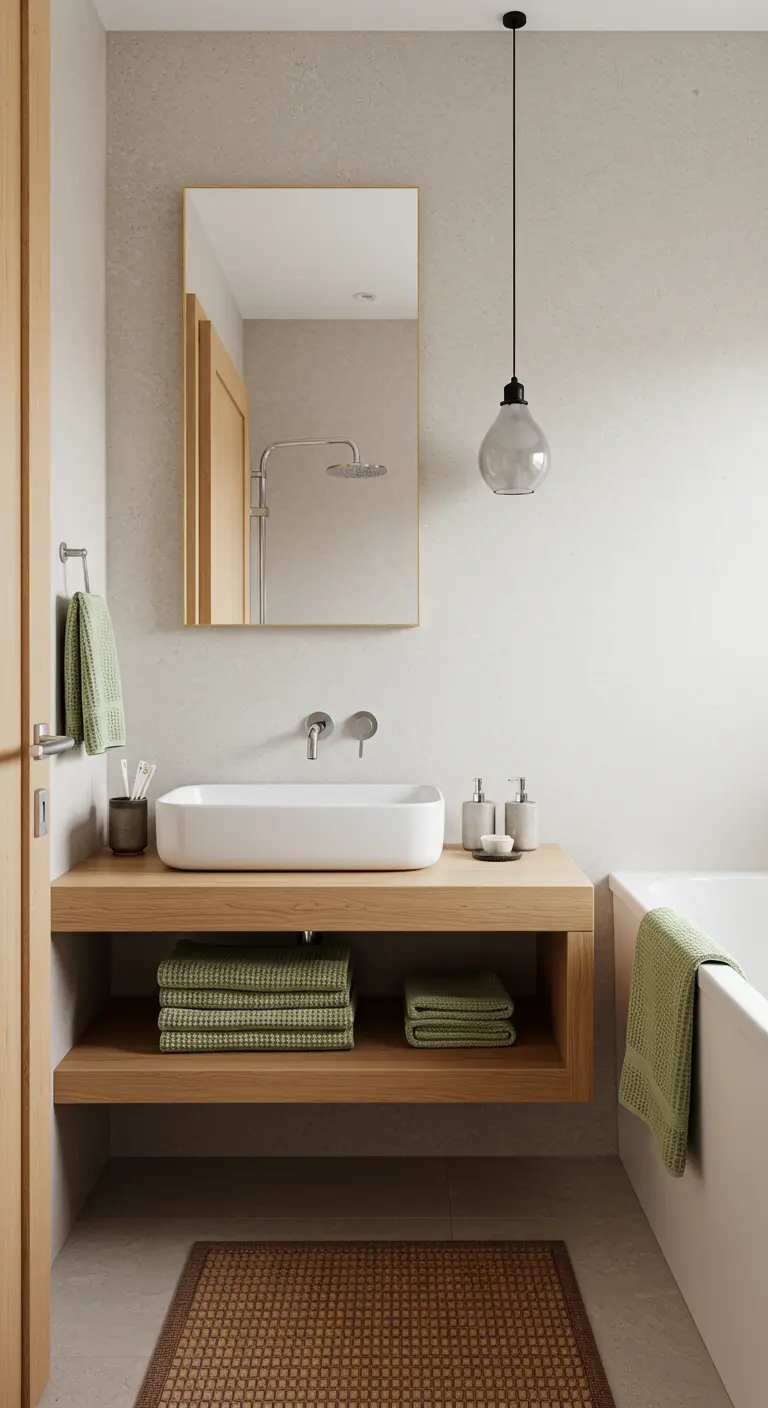
A wall-mounted or “floating” vanity is a superb choice for a small bathroom.
By lifting the cabinet off the floor, you create an uninterrupted sightline that makes the room feel significantly larger and more open.
The space underneath is also easier to clean.
A simple wood plank design with a vessel sink on top is modern, warm, and elegantly functional.
30. Create a Cozy Alcove

A built-in sleeping nook or “box bed” offers the ultimate feeling of coziness and security.
It creates a distinct, room-within-a-room that feels like a personal retreat.
Lined entirely in light wood, the nook is warm and enveloping.
A single, well-placed wall sconce provides intimate lighting for reading, while a drawer below can offer hidden storage.
It’s a modern take on classic, efficient design.
